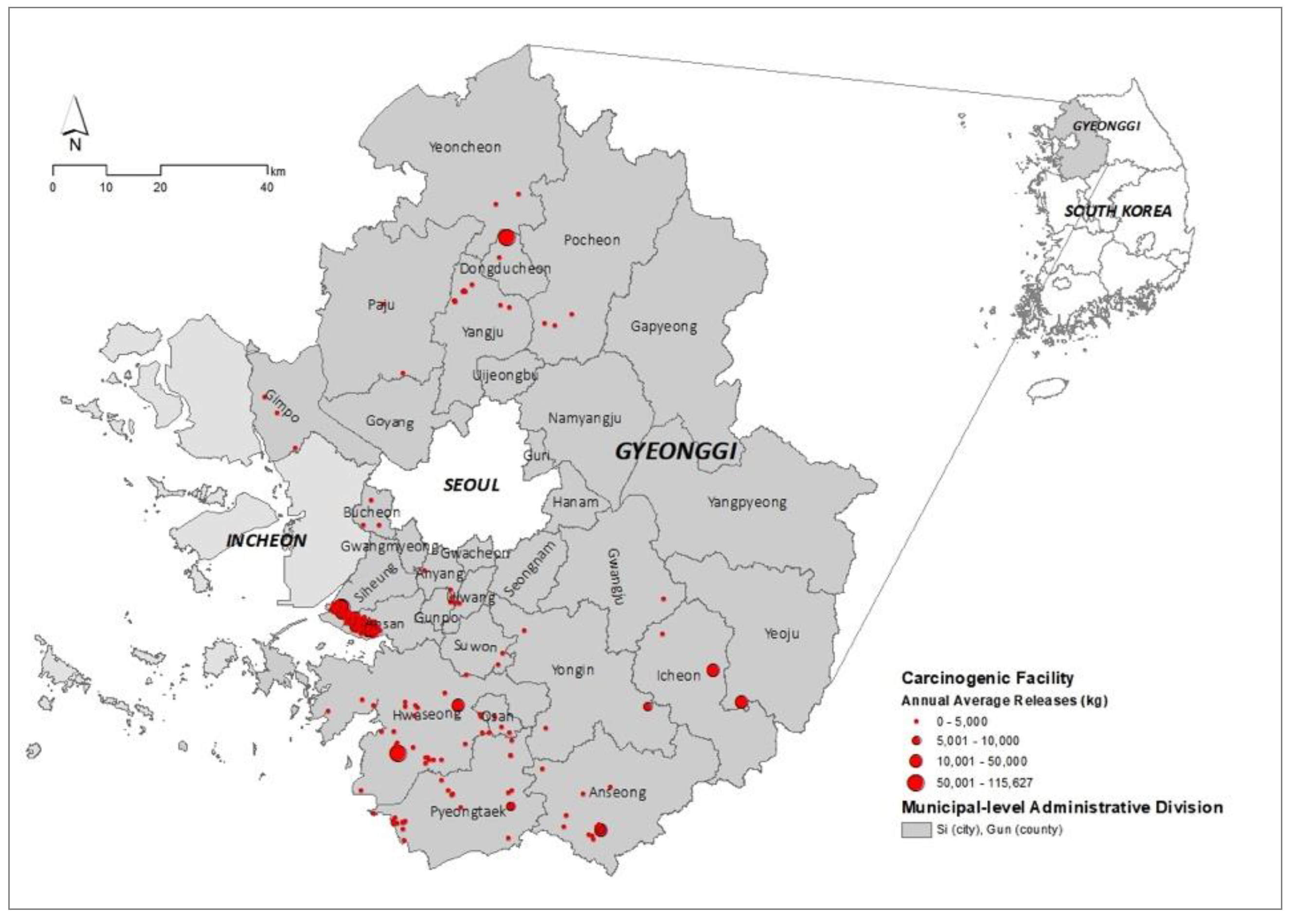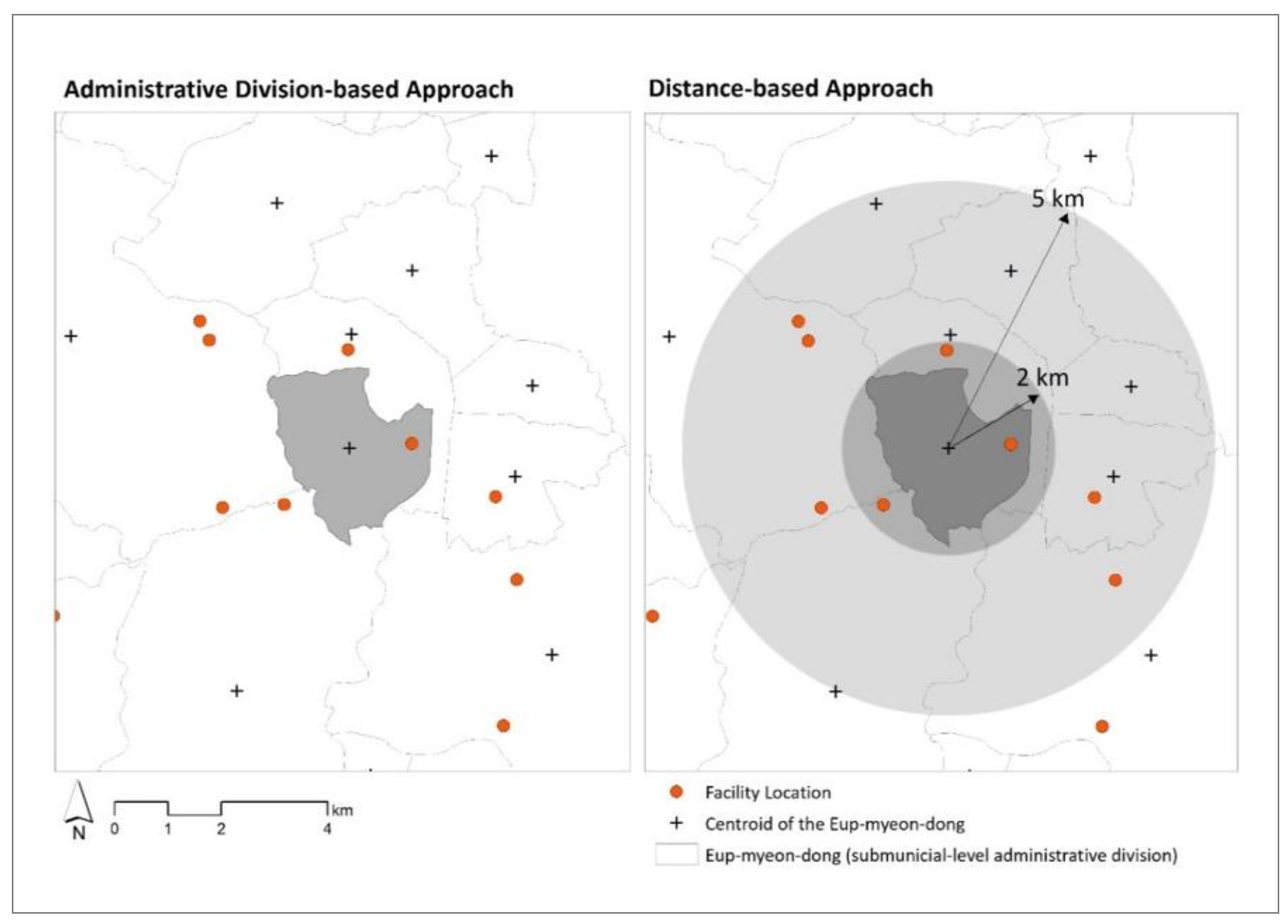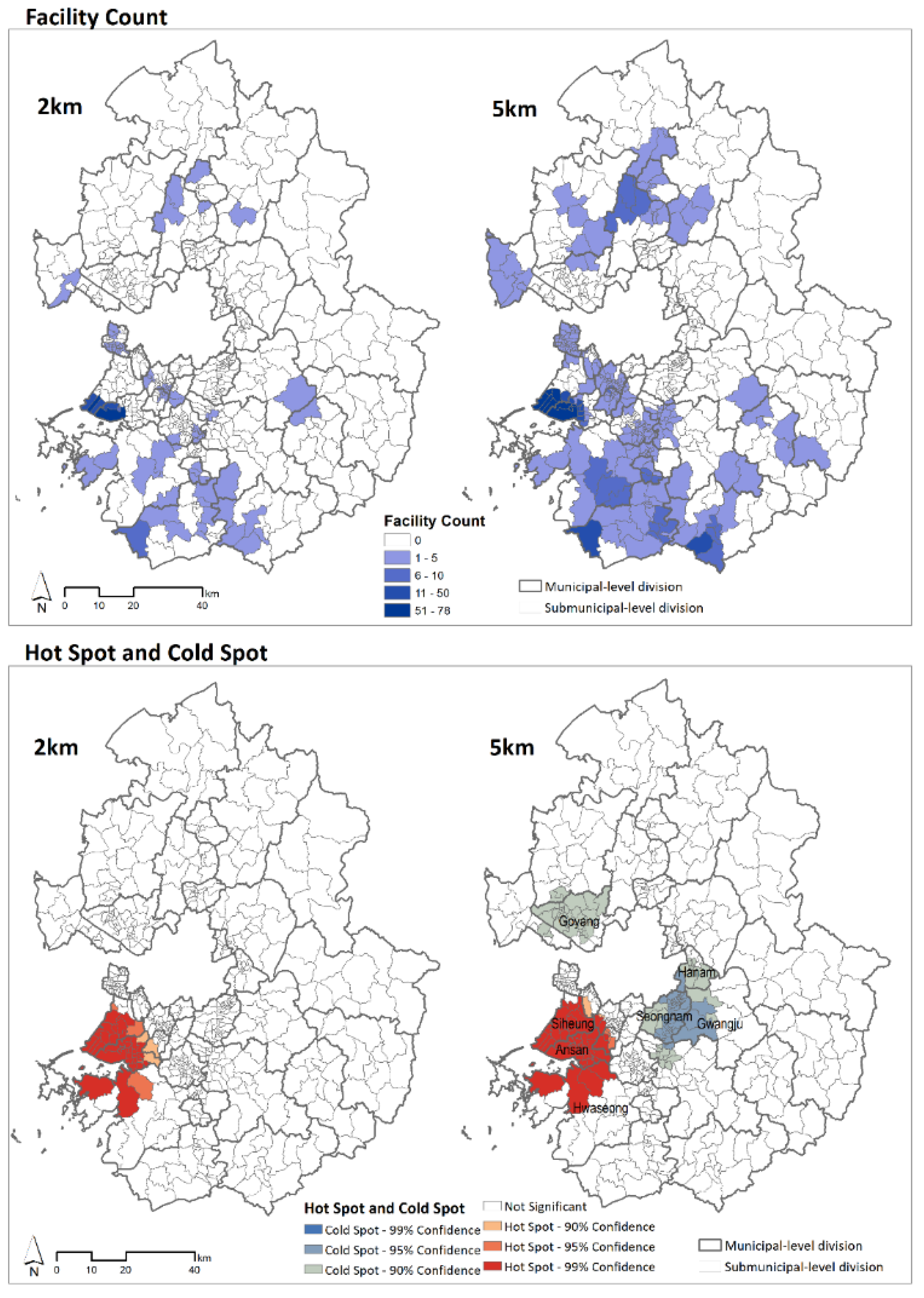Examining the Association between Socioeconomic Status and Exposure to Carcinogenic Emissions in Gyeonggi of South Korea: A Multi-Level Analysis
Abstract
1. Introduction
2. Materials and Method
2.1. Study Area
2.2. Data
3. Methods
3.1. Spatial Assessment of Facilities that Produce Carcinogenic Emissions
3.2. Examining SES Factors Associated with Exposure to Carcinogenic Emissions from Industrial Facilities
4. Results and Discussion
4.1. Spatial Patterns of Facilities that Produce Carcinogenic Emissions
4.2. SES Factors Associated with Exposure to Carcinogenic Emissions from Industrial Facilities
5. Conclusions
Author Contributions
Funding
Conflicts of Interest
References
- Beck, U. Risk Society: Towards a New Modernity; Sage: London, UK, 1992. [Google Scholar]
- Yun, S.-J. Looking at the selection process of low and medium level radioactive waste disposal site from an environmental justice perspective. ECO 2006, 10, 7–42. [Google Scholar]
- Chakraborty, J.; Green, D. Australia’s first national level quantitative environmental justice assessment of industrial air pollution. Environ.Res. Lett. 2014, 9, 1–10. [Google Scholar] [CrossRef]
- Harper, S.; Ruder, E.; Roman, H.A.; Geggel, A.; Nweke, O.; Payne-Sturges, D.; Levy, J.I. Using inequality measures to incorporate environmental justice into regulatory analyses. Int. J. Env. Res. Public Health 2013, 10, 4039–4059. [Google Scholar] [CrossRef] [PubMed]
- Lee, S.; Mohai, P. Racial and socioeconomic assessments of neighborhoods adjacent to small-scale brownfield sites in the Detroit region. Environ. Practise 2011, 13, 340–353. [Google Scholar] [CrossRef]
- Wilson, S.M.; Fraser-Rahim, H.; Williams, E.; Zhang, H.; Rice, L.; Svendsen, E.; Abara, W. Assessment of the distribution of toxic release inventory facilities in metropolitan Charleston: An environmental justice case study. Am. J. Public Health 2012, 102, 1974–1980. [Google Scholar] [CrossRef]
- Wilson, S.; Burwell-Naney, K.; Jiang, C.; Zhang, H.; Samantapudi, A.; Murray, R.; Dalemarre, L.; Rice, L.; Williams, E. Assessment of sociodemographic and geographic disparities in cancer risk from air toxics in South Carolina. Environ. Res. 2015, 140, 562–568. [Google Scholar] [CrossRef] [PubMed]
- Jephcote, C.; Chen, H. Environmental injustices of children’s exposure to air pollution from road-transport within the model British multicultural city of Leicester: 2000–09. Sci. Total Environ. 2012, 414, 140–151. [Google Scholar] [CrossRef] [PubMed]
- Grineski, S.E.; Collins, T.W.; Morales, D.X. Asian Americans and disproportionate exposure to carcinogenic hazardous air pollutants: A national study. Soc.Sci. Med. 2017, 185, 71–80. [Google Scholar] [CrossRef] [PubMed]
- Kershaw, S.; Gower, S.; Rinner, C.; Campbell, M. Identifying inequitable exposure to toxic air pollution in racialized and low-income neighbourhoods to support pollution prevention. Geospat. Health 2013, 7, 265–278. [Google Scholar] [CrossRef]
- Beck, U.; Grande, E. Varieties of second modernity: The cosmopolitan turn in social and political theory and research. Br. J. Sociol. 2010, 61, 409–443. [Google Scholar] [CrossRef]
- Huh, J.Y.; Bak, H.-J. Unequal distribution in the production of environmental risks and environmental justice: The case of chemical pollution emission in Korea. ECO 2017, 21, 229–268. [Google Scholar]
- Kraft, M.E.; Stephan, M.; Abel, T.D. Coming Clean: Information Disclosure and Environmental Performance; The MIT Press: Cambridge, MA, USA, 2011. [Google Scholar]
- Daniels, G.; Friedman, S. Spatial inequality and the distribution of industrial toxic releases: Evidence from the 1990 TRI. Soc. Sci. Q. 1999, 80, 244–262. [Google Scholar]
- Čapek, S.M. The “environmental justice” frame: A conceptual discussion and an application. Soc. Probl. 1993, 40, 5–24. [Google Scholar] [CrossRef]
- Chakraborty, J.; Armstrong, M.P. Exploring the use of buffer analysis for the identification of impacted areas in environmental equity assessment. Cartogr. Geogr. Inf. Syst. 1997, 24, 145–157. [Google Scholar] [CrossRef]
- Allen, D.W. Social class, race, and toxic releases in American counties, 1995. Soc.Sci. J. 2001, 38, 13–25. [Google Scholar] [CrossRef]
- Pastor, M.; Morello-Frosch, R.; Sadd, J.L. The air is always cleaner on the other side: Race, space, and ambient air toxics exposures in California. J. Urban Aff. 2005, 27, 127–148. [Google Scholar] [CrossRef]
- Pastor, M.; Sadd, J.L.; Morello-Frosch, R. Waiting to inhale: The demographics of toxic air release facilities in 21st-century California. Soc. Sci. Q. 2004, 85, 420–440. [Google Scholar] [CrossRef]
- Abel, T.D. Skewed riskscapes and environmental injustice: A case study of metropolitan St. Louis. Environ. Manage. 2008, 42, 232–248. [Google Scholar] [CrossRef]
- Chun, Y.; Kim, Y.; Campbell, H. Using Bayesian methods to control for spatial autocorrelation in environmental justice research: An illustration using toxics release inventory data for a Sunbelt county. J. Urban Aff. 2012, 34, 419–439. [Google Scholar] [CrossRef]
- James, W.; Jia, C.; Kedia, S. Uneven magnitude of disparities in cancer risks from air toxics. Int. J. Env. Res. Public Health 2012, 9, 4365–4385. [Google Scholar] [CrossRef]
- Goodman, A.; Wilkinson, P.; Stafford, M.; Tonne, C. Characterising socio-economic inequalities in exposure to air pollution: A comparison of socio-economic markers and scales of measurement. Health Place 2011, 17, 767–774. [Google Scholar] [CrossRef] [PubMed]
- Fecht, D.; Fischer, P.; Fortunato, L.; Hoek, G.; de Hoogh, K.; Marra, M.; Kruize, H.; Vienneau, D.; Beelen, R.; Hansell, A. Associations between air pollution and socioeconomic characteristics, ethnicity and age profile of neighbourhoods in England and the Netherlands. Environ. Pollut. 2015, 198, 201–210. [Google Scholar] [CrossRef]
- Fernández-Somoano, A.; Tardon, A. Socioeconomic status and exposure to outdoor NO2 and benzene in the Asturias INMA birth cohort, Spain. J. Epidemiol. Community Health 2014, 68, 29–36. [Google Scholar] [CrossRef] [PubMed]
- Lavigne, É.; Bélair, M.-A.; Do, M.T.; Stieb, D.M.; Hystad, P.; van Donkelaar, A.; Martin, R.V.; Crouse, D.L.; Crighton, E.; Chen, H. Maternal exposure to ambient air pollution and risk of early childhood cancers: A population-based study in Ontario, Canada. Environ. Int. 2017, 100, 139–147. [Google Scholar] [CrossRef] [PubMed]
- Temam, S.; Burte, E.; Adam, M.; Antó, J.M.; Basagaña, X.; Bousquet, J.; Carsin, A.-E.; Galobardes, B.; Keidel, D.; Künzli, N. Socioeconomic position and outdoor nitrogen dioxide (NO2) exposure in western Europe: A multi-city analysis. Environ. Int. 2017, 101, 117–124. [Google Scholar] [CrossRef] [PubMed]
- Kaufman, J.S.; Cooper, R.S. Commentary: Considerations for use of racial/ethnic classification in etiologic research. Am. J. Epidemiol. 2001, 154, 291–298. [Google Scholar] [CrossRef] [PubMed]
- Lejano, R.P.; Iseki, H. Environmental justice: Spatial distribution of hazardous waste treatment, storage and disposal facilities in Los Angeles. J. Urban Plan. Dev. 2001, 127, 51–62. [Google Scholar] [CrossRef]
- Morello-Frosch, R.; Pastor, M., Jr.; Porras, C.; Sadd, J. Environmental justice and regional inequality in southern California: Implications for ruture research. Environ. Health Perspect. 2002, 110, 149–154. [Google Scholar] [CrossRef] [PubMed]
- Hajat, A.; Hsia, C.; O’Neill, M.S. Socioeconomic disparities and air pollution exposure: A global review. Curr. Environ. Health Rep. 2015, 2, 440–450. [Google Scholar] [CrossRef]
- Yoon, D.; Kang, J.E.; Park, J. Exploring environmental inequity in South Korea: An analysis of the distribution of toxic release inventory (TRI) facilities and toxic releases. Sustainability 2017, 9, 1886. [Google Scholar] [CrossRef]
- Grineski, S.E.; Clark-Reyna, S.E.; Collins, T.W. School-based exposure to hazardous air pollutants and grade point average: A multi-level study. Environ. Res. 2016, 147, 164–171. [Google Scholar] [CrossRef] [PubMed]
- Raudenbush, S.W.; Bryk, A.S. Hierarchical Linear Models: Applications and Data Analysis Methods; Sage: Thousand Oaks, CA, USA, 2002. [Google Scholar]
- Korea National Statistical Office. Census on Establishments. 2016. Available online: http://kosis.kr/statisticsList/statisticsListIndex.do?menuId=M_01_01&vwcd=MT_ZTITLE&parmTabId=M_01_01 (accessed on 15 May 2018).
- National Institute of Chemical Safety. Report on the Results of Chemical Emissions Survey for 2015; National Institute of Chemical Safety: Daejeon, Korea, 2016.
- Korea National Institute of Chemical Safety. Pollutant Release and Transfer Registers (PRTR) information system. Available online: http://ncis.nier.go.kr/ (accessed on 15 May 2018).
- Yu, S.; Bae, H. Trends in toxic chemical releases in Korea: Comparison between total releases and human health risk levels in the period 2004 to 2012. J. Environ. Policy Adm. 2015, 23, 21–41. [Google Scholar] [CrossRef]
- Baden, B.M.; Noonan, D.S.; Turaga, R.M.R. Scales of justice: Is there a geographic bias in environmental equity analysis? J. Environ. Plan. Manage. 2007, 50, 163–185. [Google Scholar] [CrossRef]
- Openshaw, S. The Modifiable Areal Unit Problem; Geo Books: Idukki, India, 1984. [Google Scholar]
- Joo, H.; Lee, Y.; Im, O.; Yoo, J. A Study on the Improvement of Environmental Impact Assessment of Industrial Complexes Based on Risk Assessment of Chemical Leakage Accidents; Korea Environment Institute: Seoul, Korea, 2013. [Google Scholar]
- Kim, N. 30% Emissions of Carcinogens Throughout the Country, Oh-chang SOS. Chungbuk In News (16 May 2016). Available online: http://m.cbinews.co.kr/news/articleView.html?idxno=89676 (accessed on 20 June 2018).
- Hox, J.J.; Moerbeek, M.; van de Schoot, R. Multilevel Analysis: Techniques and Applications, 3rd ed.; Routledge: New York, NY, USA, 2017. [Google Scholar]
- Ord, J.K.; Getis, A. Local spatial autocorrelation statistics: Distributional issues and an application. Geogr Anal. 1995, 27, 286–306. [Google Scholar] [CrossRef]
- Bowen, W.M.; Salling, M.J.; Haynes, K.E.; Cyran, E.J. Toward environmental justice: Spatial equity in Ohio and Cleveland. Ann. Assoc. Am. Geogr. 1995, 85, 641–663. [Google Scholar] [CrossRef]
- Park, S.; Jung, S. Spatial distribution of foreign population and policy implications in South Korea. Korea Sp. Plan. Rev. 2010, 64, 59–76. [Google Scholar] [CrossRef]
- Kim, S.-Y.; Lee, J.-Y.; Nam, K.-S. Policy response to the social exclusion of unskilled migrant workers. J. Asia-Pacific Stud. 2008, 15, 1–30. [Google Scholar]
- Lee, H.S.; Kim, Y. A study on the labor environment of foreign workers in Gyeonggi province. J. Soc.Sci. 2012, 1, 1–22. [Google Scholar]
- Wilson, S.M. An ecologic framework to study and address environmental justice and community health issues. Environ. Justice 2009, 2, 15–23. [Google Scholar] [CrossRef]
- Flanagan, S.V.; Spayd, S.E.; Procopio, N.A.; Marvinney, R.G.; Smith, A.E.; Chillrud, S.N.; Braman, S.; Zheng, Y. Arsenic in private well water part 3 of 3: Socioeconomic vulnerability to exposure in Maine and New Jersey. Sci. Total Environ. 2016, 562, 1019–1030. [Google Scholar] [CrossRef]
- Gee, G.C.; Payne-Sturges, D.C. Environmental health disparities: A framework integrating psychosocial and environmental concepts. Environ. Health Perspect. 2004, 112, 1645–1653. [Google Scholar] [CrossRef] [PubMed]
- Bouwes, N.; Hassur, S.M.; Shapiro, M.D. Empowerment Through Risk-Related Information: EPA’s Risk Screening Environmental Indicators Project; Political Economy Research Institute, University of Massachusetts at Amherst: Amherst, MA, USA, 2001; Volume 136. [Google Scholar]
- O’Rourke, D.; Macey, G.P. Community environmental policing: Assessing new strategies of public participation in environmental regulation. J. Policy Anal. Manag. 2003, 22, 383–414. [Google Scholar] [CrossRef]



| Variable | Mean/Freq. | SD/Percent | ||
|---|---|---|---|---|
| Dependent variable | Facility count (2 km) | 0.6 | 4.4 | |
| Facility count (5 km) | 3.1 | 12.7 | ||
| Independent variable | Individual level (Level 1) | |||
| Age | Age | 51.3 | 14.3 | |
| Age2 | 2834.0 | 1519.5 | ||
| Gender | Male | 16,903 | 84.5 | |
| Female | 3097 | 15.5 | ||
| Number of children under 15 | 0.4 | 0.7 | ||
| Number of elderly, i.e., 65 or above | 0.4 | 0.7 | ||
| Education attainment | Middle school or less | 2403 | 12.0 | |
| High school | 8127 | 40.6 | ||
| College | 4060 | 20.3 | ||
| Bachelor | 5106 | 25.5 | ||
| Graduate or above | 304 | 1.5 | ||
| Household income | First quartile | 5185 | 25.9 | |
| Second quartile | 4929 | 24.6 | ||
| Third Quartile | 4992 | 25.0 | ||
| Fourth Quartile | 4894 | 24.5 | ||
| National basic livelihood security | Non-recipient | 19,667 | 98.3 | |
| Recipient | 333 | 1.7 | ||
| Employment status | Employed | 16,968 | 84.8 | |
| Unemployed | 314 | 1.6 | ||
| Inactive | 2718 | 13.6 | ||
| Work status | Self-employed | 3932 | 19.7 | |
| Regular | 12,609 | 63.1 | ||
| Temporary | 329 | 1.7 | ||
| Unpaid family worker | 98 | 0.5 | ||
| Housing tenure | Owner-occupied | 11,831 | 59.2 | |
| Rental | 7983 | 39.9 | ||
| Municipal level (Level 2) | ||||
| Population density (person/km2) | 3290 | 3714 | ||
| Percentage of industrial land use | 2.1 | 2.7 | ||
| Percentage of foreign-born residents | 3.6 | 2.4 | ||
| 2 km Distance Model | 5 km Distance Model | ||||
|---|---|---|---|---|---|
| Individual level (Level 1) | |||||
| Age | Ln (Age) | 0.018 | (1.319) | 0.004 | (0.654) |
| Ln (Age2) | −0.000 | (−1.466) | −0.000 | (−0.803) | |
| Gender | Male (ref.) | ||||
| Female | 0.089 | (1.443) | 0.034 | (1.095) | |
| Number of children under 15 | 0.054 | (1.490) | 0.018 | (0.952) | |
| Number of elderly, i.e., 65 or above | 0.003 | (0.050) | −0.030 | (−1.108) | |
| Education attainment | Middle school or less (ref.) | ||||
| High school | 0.007 | (0.081) | −0.068 | (−1.606) | |
| College | −0.017 | (−0.167) | −0.021 | (−0.401) | |
| Bachelor | 0.060 | (0.585) | −0.003 | (−0.066) | |
| Graduate or above | 0.412 ** | (2.198) | 0.086 | (0.877) | |
| Household income | First quartile (ref.) | ||||
| Second quartile | 0.110 | (1.526) | 0.062 * | (1.759) | |
| Third Quartile | 0.094 | (1.236) | 0.032 | (0.870) | |
| Fourth Quartile | 0.357 *** | (4.679) | 0.163 *** | (4.337) | |
| National basic livelihood security | Non-recipient (ref.) | ||||
| Recipient | 0.209 | (1.224) | 0.306 *** | (3.679) | |
| Employment status | Employed (ref.) | ||||
| Unemployed | 0.075 | (0.410) | 0.168 * | (1.888) | |
| Inactive | 0.283 *** | (2.802) | 0.064 | (1.292) | |
| Work status | Self-employed (ref.) | ||||
| Regular | 0.079 | (1.235) | 0.080 ** | (2.516) | |
| Temporary | 0.075 | (0.414) | −0.078 | (−0.868) | |
| Unpaid family worker | −0.403 | (−1.140) | −0.557 *** | (−3.225) | |
| Housing tenure | Owner-occupied (ref.) | ||||
| Rental | 0.142 *** | (2.591) | 0.061** | (2.221) | |
| Other | −0.388 | (−1.325) | −0.458 *** | (−3.143) | |
| Municipal level (Level 2) | |||||
| Population density | −0.000 | (−0.868) | −0.000 | (−0.195) | |
| Percentage of industrial land use | 1.009 *** | (3.430) | 0.695 *** | (2.599) | |
| Percentage of foreign-born residents | 0.571 ** | (2.027) | 0.568 ** | (2.225) | |
| Cons | −8.510 *** | (−6.551) | −5.291 *** | (−4.921) | |
| Model Summary | |||||
| Number of observations | 20,000 | 20,000 | |||
| Number of group | 31 | 31 | |||
| AIC | 22,756.66 | 52,258.74 | |||
| BIC | 23,001.67 | 52,503.75 | |||
© 2019 by the author. Licensee MDPI, Basel, Switzerland. This article is an open access article distributed under the terms and conditions of the Creative Commons Attribution (CC BY) license (http://creativecommons.org/licenses/by/4.0/).
Share and Cite
Park, J.-I.; Kwon, H.-S. Examining the Association between Socioeconomic Status and Exposure to Carcinogenic Emissions in Gyeonggi of South Korea: A Multi-Level Analysis. Sustainability 2019, 11, 1777. https://doi.org/10.3390/su11061777
Park J-I, Kwon H-S. Examining the Association between Socioeconomic Status and Exposure to Carcinogenic Emissions in Gyeonggi of South Korea: A Multi-Level Analysis. Sustainability. 2019; 11(6):1777. https://doi.org/10.3390/su11061777
Chicago/Turabian StylePark, Jeong-Il, and Hye-Seon Kwon. 2019. "Examining the Association between Socioeconomic Status and Exposure to Carcinogenic Emissions in Gyeonggi of South Korea: A Multi-Level Analysis" Sustainability 11, no. 6: 1777. https://doi.org/10.3390/su11061777
APA StylePark, J.-I., & Kwon, H.-S. (2019). Examining the Association between Socioeconomic Status and Exposure to Carcinogenic Emissions in Gyeonggi of South Korea: A Multi-Level Analysis. Sustainability, 11(6), 1777. https://doi.org/10.3390/su11061777





